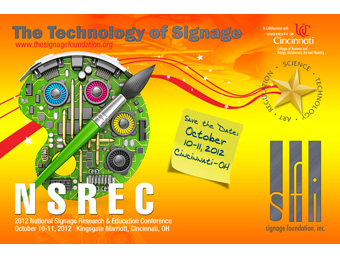 The National Signage Research & Education Conference (NSREC) held October 10-11, 2012 at the Kingsgate Marriott on the University of Cincinnati (UC) campus, presented comprehensive data about signage from numerous perspectives. Leading representatives from the University of Cincinnati, Texas A&M University and the University of Oklahoma provided the latest research about the economic value of signs; before-and-after, traffic-accident reports that reveal electronic message centers (EMCs) don’t impact traffic safety; and the process by which sign codes can be based on real data, not just subjective opinion.
The National Signage Research & Education Conference (NSREC) held October 10-11, 2012 at the Kingsgate Marriott on the University of Cincinnati (UC) campus, presented comprehensive data about signage from numerous perspectives. Leading representatives from the University of Cincinnati, Texas A&M University and the University of Oklahoma provided the latest research about the economic value of signs; before-and-after, traffic-accident reports that reveal electronic message centers (EMCs) don’t impact traffic safety; and the process by which sign codes can be based on real data, not just subjective opinion.
These were just a few of the sessions packed into an intensive, one-and-a-half-day conference hosted by the Signage Foundation, Inc.(SFI) in collaboration with Colleges of Business and DAAP at the University of Cincinnati. Based on the S.T.A.R. initiative (Science, Technology, Art/Advertising and Regulation), this year’s conference focused on Technology. NSREC is designed for planners; governmental regulators; appraisers; marketing/branding specialists; businesses that use signage; students and faculty who study signage’s impact on business, social and visual environments; and sign makers and their suppliers.
In a one-and-a-half-year study conducted by UC’s research department, in conjunction with professors from the school’s economic, planning and architecture departments, more than 225 local and national businesses collectively reported that upgrades to their signage boosted sales by an average of 12 percent and helped create new jobs for nearly one in four businesses.
In addition, the study included specific case histories in which Value Place reported that EMCs boosted sales by an average of 11 percent; a 500-branch bank stated that the addition of pylon signs increased teller transactions by 15 percent; and the addition of an EMC at Chuck Anderson Ford in Excelsior Springs, Missouri, increased sales more than 10 percent and allowed it to hire six additional people.
The researchers concluded, “Nearly all businesses have a need for effective, on-premise signs to help them succeed. While such signs serve an important function for these buyers and sellers, the economic considerations of on-premise signage also extend beyond their value to business owners. To the extent that signs and sign regulations promote or hinder business activity, there is an impact on the vitality of commercial areas and the tax collections of local governments.”
Texas A&M University presented the preliminary results from the most comprehensive study of EMCs and traffic-accident data: “We did not find a statistically significant impact.” While previously studies have looked at singular sites or have been based primarily on conjecture, this study examined data over at least a four-year period at numerous locations in four states. Dr. H. Gene Hawkins, an associate professor in civil engineering at A&M, as well as a research engineer with the Texas Transportation Institute, spearheaded the study and presented the results at NSREC.
Using the latest research technology, the Empirical Bayes method, the study used data from 2005-2009 in California, North Carolina, Ohio and Washington, taken from the Federal Highway Administration’s Highway Safety Information System. Crashes were tabulated within 0.1 miles on both sides of the EMCs, which were confirmed using both Google Street View and milepost information.
Dr. Dawn Jourdan of the University of Oklahoma presented an Evidence-Based Sign Code. A land-use attorney, city planner and an associate professor of planning, she was assisted by Texas A&M’s Dr. Hawkins and academicians from the University of North Texas and North Carolina State. Too often, sign codes are based on conjecture or unsubstantiated opinion. In contrast, the Model Sign Code (MSC) includes very specific calculations for determining minimum letter heights.
Jourdan cites Edenfield v. Fame (1992) as evidence that “local governments must prove that any harm they seek to address with an ordinance is materially advanced by the proposed regulations. This ruling compels governments to do more than allege (emphasis added) traffic safety or aesthetics concerns as the basis for signage regulations.” Jourdan also specifically supports content neutrality in sign codes.
Another UC professor, Dr. James Kellaris, who sits in the James S. Womack/Gemini Chair of Signage and Visual Marketing in the College of Business, reported the results of a national survey involving readers of Better Homes and Gardens.
The American Grocery Shopper Study™, conducted by research firm BrandSpark, included responses from varying age groups in all fifty states.
+ More than a third reported having been drawn into a store because of attractive signage.
+ More than 40 percent “made quality assumptions” based on a store’s signs.
+ More than 60 percent “have driven by and failed to find a business because the signage was too small or unclear.”
+ More than 75 percent said signage was one of the first things they noticed about new or unfamiliar buildings.
+ More than 85 percent said signs can convey the character of a business.
+ More than 80 percent get frustrated and annoyed when they can’t read signs.
In other sessions:
Former International Sign Association chairman Steve Kieffer, a recipient of the association’s lifetime-contribution Kirk L. Brimley Distinguished Achievement Award, presented a comprehensive glossary and classification system for signage.
UC professor Craig Vogel (School of Design, Architecture, Art and Planning) expanded the definition of “signage” with a presentation that examined communication efforts in urban centers and metropolitan areas.
A presentation on the history of signage documented how technology (neon, formed plastic, computerization and, most recently, LEDs) has transformed the sign industry over the past century.
A UC planning student, who worked as an intern at United-Maier, a local sign company last summer, spoke about the invaluable experience he received while attending sales calls, acquiring permits, witnessing a rooftop installation and assisting with in-house fabrication.
All attendees received a 200+ page book of the proceedings. Synopses of the results will be posted on the Signage Foundation Web site. http://www.thesignagefoundation.org











